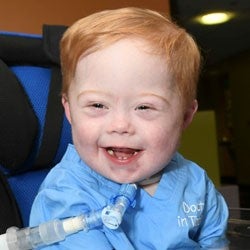Exton Black
September 25, 2019
Categories: Patient Stories
Tags: Tracheomalacia/Bronchomalacia, Tracheomalacia, Bronchomalacia
Tracheomalacia/Bronchomalacia
Savannah Black can describe the first days of her first born’s life in one word – chaos. Exton Timothy came into the world six weeks early in February 2017 and was soon diagnosed with Down syndrome. At 6 weeks old, he underwent surgery at Children’s of Alabama to repair a hole in his heart, then he had surgery for a G-tube (feeding tube) placement because he wasn’t eating. Nine days after Exton was discharged home, on the Blacks’ wedding anniversary, Exton stopped breathing during a 2 a.m. feeding. Savannah administered CPR and it took three rounds of compressions to revive him. Exton was flown by jet from his hometown of Opelika, Alabama back to Children’s, where the Blacks learned Exton’s airways were 90% collapsed. He was diagnosed with tracheomalacia/bronchomalacia – a condition in which the walls of the trachea (windpipe) or bronchi (branches of the windpipe) are abnormally soft, leading to narrowing or closure during exhalation. Exton had chronic respiratory failure and would need a ventilator to breathe. At the time, Savannah’s only experience with a ventilator was through the television show “Grey’s Anatomy.” If you’re on a ventilator, she thought, you’re a vegetable. “We lived on 10 Quarterback for almost four months,” said Savannah, referencing Children’s Pulmonary Care Unit. “Once we transferred to 10 Quarterback, our care team decided we would be a good fit for the Home Ventilator Program.” Children’s Home Ventilator Program cares for children who have chronic lung/airway disease requiring a tracheostomy and/or prolonged invasive and noninvasive ventilation at home. The Blacks panicked at the thought of caring for Exton at home – two hours away from Children’s – without the support and proximity of the doctors, nurses and respiratory therapists on the unit. “My husband and I have zero medical background and we went through 10 weeks of hard training,” Savannah said. “The program is customized to your child’s needs and what works best for your family. It’s very meticulous, very detailed, very organized.” The Blacks learned how to operate Exton’s hospital equipment and at-home equipment, how to administer medication, how to insert and remove a tracheostomy tube. They were tested on their knowledge and technique. They were graded. “You learn sideways, upways and backways,” Savannah said. “It was the most intense thing I’ve done in my life.” The intensity sometimes proved too much to bear, but the Blacks’ care team – their teachers – were their shoulder to cry on, too. By the training’s end, the Blacks were armed with the knowledge and ability to care for their son. Graduation was contingent upon two things – procedures performed successfully on a dummy in Children’s Pediatric Simulation Center and a public outing with Exton under the watchful eye of his nurses. Savannah chose a shopping mall for the outing, and the Blacks had to show the nurses everything they learned. “The nurses just observe. They aren’t allowed to do anything unless something crazy happens,” Savannah said. Though they graduated “with honors,” the Blacks were still anxious about returning to Opelika without the safety net of Exton’s care team. That was until they were faced with their first challenge – Exton’s secretion levels were out of whack. They sprung to action and solved the problem quickly. By themselves. “It took one scenario for our training to kick in. That’s when we realized we got this. That’s when we said, ‘We’re never going back to the hospital again. We’re staying home,’” Savannah said. “We haven’t had another readmission in two years. Children’s taught us how to make this medical stuff normal and they do it with such grace.” The Blacks today live a less chaotic life, caring for Exton and welcoming their second child, son Gibson. The family visits Children’s every three months for Exton’s outpatient clinic appointments and meets with every member of his multidisciplinary care team. Future surgeries and procedures are scheduled, nutrition plans are tweaked, data from Exton’s ventilator is downloaded and reviewed. Each member of Exton’s care team meets the family in outpatient clinic to prevent them from traveling to various specialists throughout the hospital. The team also updates Exton’s care plan, a comprehensive 15-page packet of Exton’s medical history – diagnoses, surgeries, medications, ventilator settings, physician contacts, etc. – that the Blacks share with healthcare professionals outside of Children’s. “I cannot tell you how many times it has saved our butt,” Savannah said of the care plan. It has to be in my go-bag and in my purse at all times.” Reflecting on Exton’s journey, Savannah is grateful for the support of Children’s and the camaraderie among the “vent moms and dads” she has gotten to know over the past two years. As for Exton, he’s a “dancing fool who thinks he needs to be the center of attention,” Savannah said. “He’s so much fun. He’s a wild man!” Savannah continued, “I remember being so afraid and a nurse said to me, ‘If you hug him tight enough and love him hard enough, you won’t even feel those tubes. Make it your normal. Get your kid out of here and live your life,'” Savannah said. “Before the Home Ventilator Program, you couldn’t take your child home. It’s so awesome we have this type of technology to bring our kids home.”






